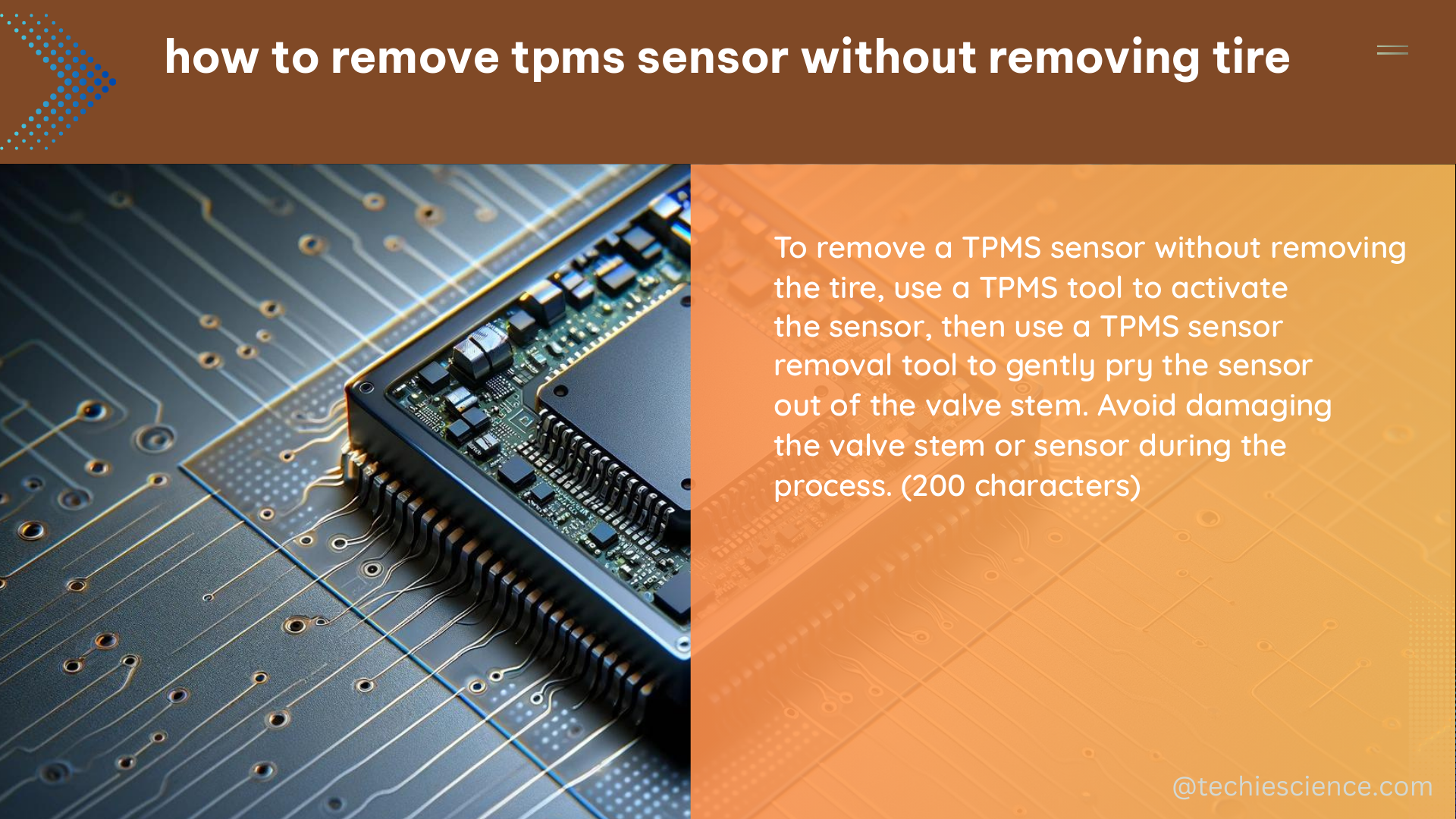Removing a TPMS (Tire Pressure Monitoring System) sensor without removing the tire can be a challenging task, but it is possible with the right tools and techniques. This comprehensive guide will walk you through the step-by-step process, providing detailed instructions and valuable insights to ensure a successful TPMS sensor removal without the need to remove the tire.
Valve Stem Removal: The First Step
The initial step in removing a TPMS sensor without removing the tire is to remove the valve from the valve stem. This can be accomplished using a specialized tool that fits inside the valve stem and unscrews it. Once the valve stem is removed, the air will rush out, allowing you to break the bead of the tire.
It’s important to note that the valve stem removal process may vary depending on the specific vehicle and TPMS sensor design. Some valve stems may have a threaded design, while others may have a snap-in or push-in style. Consult your vehicle’s service manual or manufacturer’s instructions to ensure you use the appropriate tool for your TPMS valve stem.
Fishing Tool: Guiding the New Valve Stem

After removing the valve stem, you’ll need a fishing tool to guide the new valve stem into the tire. This tool is typically small and thin, allowing it to fit through the valve stem hole. Once the fishing tool is in place, you can use it to screw in the new valve stem.
When selecting a fishing tool, consider the size and shape of the valve stem hole in your vehicle. Some fishing tools may have a curved or angled design to better navigate the tight spaces within the tire. Ensure that the fishing tool you choose is compatible with the specific TPMS sensor and valve stem you’ll be installing.
Lubricant: Easing the Installation
To facilitate the installation of the new valve stem, it’s recommended to use a lubricant. Suitable lubricants include undercoating products or Armor All-type products. Alternatively, you can use a soapy water solution to help the new valve stem slide onto the wheel more easily.
The use of a lubricant can significantly reduce the effort required to install the new valve stem, especially if the wheel well or surrounding area is tight or difficult to access. Apply the lubricant liberally to the valve stem and the wheel’s valve stem hole before attempting the installation.
Torque Specifications: Ensuring Proper Installation
When installing the new TPMS sensor, it’s crucial to tighten it to the correct torque specifications. Failing to do so can result in improper sealing, sensor malfunction, or even damage to the sensor or wheel.
Consult your vehicle’s service manual or the TPMS sensor manufacturer’s instructions to determine the appropriate torque specification. As an example, the video referenced in the initial answer showed the screw for the TPMS sensor being torqued to 30 inch-pounds.
Using a torque wrench to tighten the TPMS sensor to the recommended specification is essential for ensuring a secure and reliable installation.
Programming: Integrating the New Sensor
After installing the new TPMS sensor, it will need to be programmed to the vehicle. This can be done using a TPMS tool or an equivalent scan tool that has the capability to manually enter the sensor IDs.
The programming process allows the vehicle’s TPMS computer to recognize the new sensor and register its unique identification number. Without this programming step, the TPMS system may not function correctly or may display error messages.
Consult your vehicle’s service manual or the TPMS sensor manufacturer’s instructions for the specific programming steps required for your vehicle and sensor model.
Breaking the Bead: A Challenging but Necessary Step
While it is possible to remove the TPMS sensor without removing the tire, it does require breaking the bead of the tire. This can be done by using a 2×6 or a similar object to apply leverage to the tire and break the bead.
Breaking the bead can be a time-consuming and physically demanding process, as it requires significant force to separate the tire from the wheel. It’s important to exercise caution and use the appropriate tools and techniques to avoid damaging the tire or wheel.
If you’re not comfortable with the bead-breaking process or lack the necessary tools, it may be advisable to have a professional tire technician handle this step to ensure a safe and successful TPMS sensor removal.
Conclusion
Removing a TPMS sensor without removing the tire is a complex task that requires specialized tools and a methodical approach. By following the steps outlined in this comprehensive guide, you can successfully remove and replace a TPMS sensor without the need to remove the tire.
Remember to always consult your vehicle’s service manual, manufacturer’s instructions, and safety guidelines to ensure a safe and successful TPMS sensor removal. With the right tools, techniques, and attention to detail, you can tackle this task and maintain your vehicle’s TPMS system effectively.
References:
- Video 1: How to Remove TPMS Sensor Without Removing Tire
- Video 2: How to Replace TPMS Sensor Without Removing Tire
- Forum Discussion: How to Disable Tire Pressure Monitoring System

The lambdageeks.com Core SME Team is a group of experienced subject matter experts from diverse scientific and technical fields including Physics, Chemistry, Technology,Electronics & Electrical Engineering, Automotive, Mechanical Engineering. Our team collaborates to create high-quality, well-researched articles on a wide range of science and technology topics for the lambdageeks.com website.
All Our Senior SME are having more than 7 Years of experience in the respective fields . They are either Working Industry Professionals or assocaited With different Universities. Refer Our Authors Page to get to know About our Core SMEs.